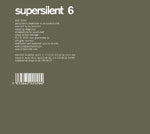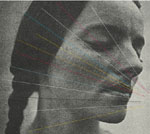UN-PIGEONHOLE-ABLE
| |

| One generic feature of the Rune Grammofon house style is a lack of information on the cd and its packaging. The sixth instalment of Supersilent's output, sees this continued minimalism at work; no band names, instruments or titles. Unless you consider 6.1, 6.2 etc. titles. Perhaps there is an assumption here that you already know who these people are and that what they do requires nothing so superfluous as a title. Dispensing with the need to place players and their instruments together seems apt when you listen to the seamless weave that Supersilent produce. The music is 'Not a matter of individual grandstanding', they say, so for the most part they submerge their identities within the collective 'Supersilent sound'. However, there is no mistaking the breathy trumpet of Arve Henriksen floating sharp and precise over crisp percussion and other less definable sounds on the cd's second track. Comparisons with some of Miles Davis' work or that of Jon Hassell's ambient forays with Brian Eno have already been made. I think that there's some similarity between this and the work done by B.L.U.E. the Bruford/Levin quartet featuring trumpeter Chris Botti, especially 'live'. Elsewhere, the influences and references are less clearly defined. Individuals will find their own no doubt, as I did, but overall the sound is identifiably their own. And it is a major part of this band's intention to create music that is as original as possible. Their layers of electronic and acoustic textures create something which is eerie, melancholy, ominous and sometimes simply bleak. For example, the opening track features several keyboards issuing dark slabs of forbidding noise and chill ululations that gradually build up an inexorable march across alien terrain. Track 4, by contrast, samples mellow guitar strings echoing over an organ which is redolent of one of Hans-Joachim Irmler's more tranquil forays. It does, in time, escalate into a more intense and turbulent construction, again, a little like a Faustian soundscape. On a couple of tracks there is even the icy breath of a mellotron recalling King Crimson, however fleetingly. But it is just one facet of the total construction. If this music is the work of 4 separate but clearly like-minded musicians then the final shaping owes a good deal to Helge Sten a.k.a. Deathprod, sound artist and 'audio virus'. His role as band member, producer and mixer is clearly crucial in fashioning the end product. From the hours of studio time he's moulded the overall mood and cohesion of the finished recording, without detracting from the collective input of the other members. The result is a disturbing but intriguing set of soundscapes. Listening to the album as a whole offers some indication of where Supersilent are at present as a 'live' in the studio outfit. It will be well worth seeing and hearing them on stage when they tour here in May. |

| There is more information on the solo cd by Maja Ratkje, details of the various locations where it was recorded, how it was recorded etc. There is even a photo of Ratkje on front and back of the cd pack. Still, I approached it with some misgivings, not having especially liked some of her contributions to the Spunk cd last year. The thought of a complete cd of her voice alone was basically repellent. But I tried to suppress my pre-conceptions and face up to what I thought would be 40 odd minutes of banshee impressions interspersed with nerve-jangling caterwauling. But I have to admit it is a good deal more varied than that. She and co-producers, Jazzkammer, have utilised locations and a range of recording methods to ensure that there is enough textural variety. For instance, on the opening track Ratkje intones a narrative of scrambled text in a child-like manner, accompanied by various samples of her voice recorded a different speeds. It is light, delicate and oddly entrancing and is followed, however, by some fierce gargling and manic whinnying on 'Joy'. Her voice is a formidable instrument and when multi-tracked and treated it often sounds nothing like the human voice at all. The title track may be the nearest she gets to recording herself in as natural a state as possible. The purity of her largely untreated vocals is astonishing. This is partly due to the acoustics of the Emmanuel Vigeland Museum, a setting which also contributed to the work of Arve Henriksen on his solo album. Here it is called 'the Mausoleum' but I think it's probably the same place and is responsible for the depth of resonance on tracks like 'Voice' and 'Vacuum' . Elsewhere on the cd there are other mixtures of location, voice and recording instrument which produce some idiosyncratic results. She uses dictaphone , hard disk, samplers and gemini tape recorder to achieve the cut, splice and loops that are evident on 'Dictaphone Jam' and 'Acid'. The sometimes frantic melange of sounds could not be produced by the voice alone but these electronic media extend the possibilities, sometimes to the limit of aural tolerance - try the all out assault of part of 'Insomnia' to see what I mean. I have to say I may never be fully comfortable with her work but this set is attractive and compelling in an unclassifiable way and it delivers much more than I had expected. © 2003 Paul Donnelly |